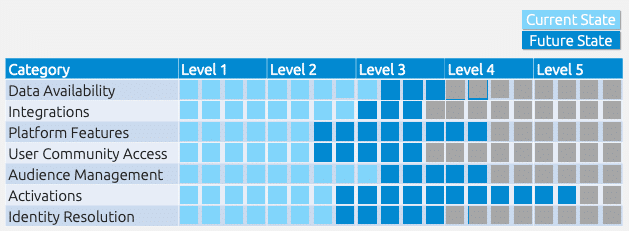Notifications
ALL BUSINESS
COMIDA
DIRECTORIES
ENTERTAINMENT
FINER THINGS
HEALTH
MARKETPLACE
MEMBER's ONLY
MONEY MATTER$
MOTIVATIONAL
NEWS & WEATHER
TECHNOLOGIA
TV NETWORKS
VIDEOS
VOTE USA 2026/2028
INVESTOR RELATIONS
COMING 2026 / 2027
ALL BUSINESS
COMIDA
DIRECTORIES
ENTERTAINMENT
FINER THINGS
HEALTH
MARKETPLACE
MEMBER's ONLY
MONEY MATTER$
MOTIVATIONAL
NEWS & WEATHER
TECHNOLOGIA
TV NETWORKS
VIDEOS
VOTE USA 2026/2028
INVESTOR RELATIONS
COMING 2026 / 2027
About Me
 Latinos Media
Latinos Media Latinos Media provides all types of news feeds on a daily basis to our Members
Posted by - Latinos Media -
on - February 28, 2023 -
Filed in - Marketing -
-
720 Views - 0 Comments - 0 Likes - 0 Reviews
Implementing a customer data platform (CDP) is no small investment. And, to paraphrase Spiderman, with great investment comes great expectations from the C-suite. What they are going to want to know is also the hardest to answer: “Are we seeing value from our CDP, and what is the ROI?”
Many studies prove CDPs drive business value. They do this by:
However, they do this in conjunction with other systems, not on their own. This makes it difficult to understand the value contribution and prove ROI. But the following framework will help you assess its value.
Dig deeper: What is a CDP and how does it give marketers the coveted ‘single view’ of their customers?
The CDP adoption frameworkDriving greater CDP adoption guarantees additional business benefit. Adoption is straightforward to understand and measure, provided you use a comprehensive framework which looks at:
This framework will provide quantitative and qualitative data to inform your understanding of:
Each CDP has its distinct collection of capabilities. That said, several categories of utilization can be analyzed for any platform as part of a universal adoption framework.

Here’s how to assess each of those seven categories.
Data availabilityYour CDP is only as good as the data residing within it. The following chart shows how to assess your data.

Your CDP fuels the experiences you create with customers through inbound or outbound channels. To create coordinated experiences consistently, it must collaborate with all key platforms, including:
Your CDP must continually augment profiles with signals captured from inbound and outbound interactions.
A well-integrated CDP connects with platforms that support relevant-time decisions without information gaps.
A CDP that isn’t designed with interoperability will not provide the level of maturity required to achieve what most organizations desire — real-time optimization at the moment of interaction.
Dig deeper: What is identity resolution and how are platforms adapting to privacy changes?
Platform features The features available in any platform typically fall into two categories:
Too often, we find that those ancillary features are forgotten and under-leveraged.
For instance, just because you have a more advanced site personalization platform doesn’t mean you can’t find opportunities to leverage out-of-the-box site personalization capabilities. They are usually fast to implement as the integration is pre-built.
User community accessWhile marketers are usually the driving force behind adoption, CDPs aren’t just for them. It is essential to drive use of the CDP by people outside of the marketing department. This requires education and strategic partnerships.
The fact is that CDP intelligence can have more impact on sales or customer service programs than on marketing which is accustomed to using rich first-party data.
The responsibility for successful CDP adoption doesn’t fall only on marketing and IT stakeholders. A team focused on CDP success must include marketing, IT, marketing analytics, sales, agencies, product, service, creative and even legal teams to establish and refine new processes for providing customer experiences.
Audience managementThis can be evaluated by looking at the following:
Simply leveraging a CDP within customer experience programs doesn’t fully indicate how well an organization has adopted a platform. What you need to do is measure the ROI from use cases enabled directly by the CDP. This is achievable with some discipline.
Whenever possible, leverage existing measurement methodologies and infrastructure to compare results from activations before and after using the CDP. Create a plan that clearly captures the KPIs, audience, creative and test group sizing before execution. Ensure all platforms and integrations are configured appropriately to support the execution and data capture required for the test.
Identity resolutionEvery CDP promises a single customer view (SCV). SCV can’t be accomplished without identity resolution, no matter the nuances in your data or mix of offline and online identifiers.
Ensure you’ve established comprehensive rules for stitching together all identifiers across all data sources. More importantly, all identifying events occurring throughout any part of the customer experience must be adequately handled by the platforms delivering those experiences.
Those platforms must capture all identifiers and their associations and provide that information to the CDP’s identity resolution processes.
Scoring your CDP
Quantitative output
In looking across the above categories in the framework, record your current and future state maturity on a scale of 1-5.
It’s important to understand that it’s unrealistic for every (any!) organization to score a 5 within all categories. This scoring should not be arbitrary.
At Actable, we have established clear definitions of maturity across multiple subcategories within each category we use in the scoring rubric. Define these guidelines before scoring to ensure you are objectively scoring individually or by committee.
Qualitative output
As you look at the gap between your current state and target state maturities, what areas do you need to focus on closing this gap?
Perhaps data quality is holding you back. Or you need to prioritize building that missing integration that will enable a better understanding of customers.
Or it’s time to implement a test of that capability or channel that you always considered a nice-to-have.
The post Measuring CDP adoption: A comprehensive framework appeared first on MarTech.